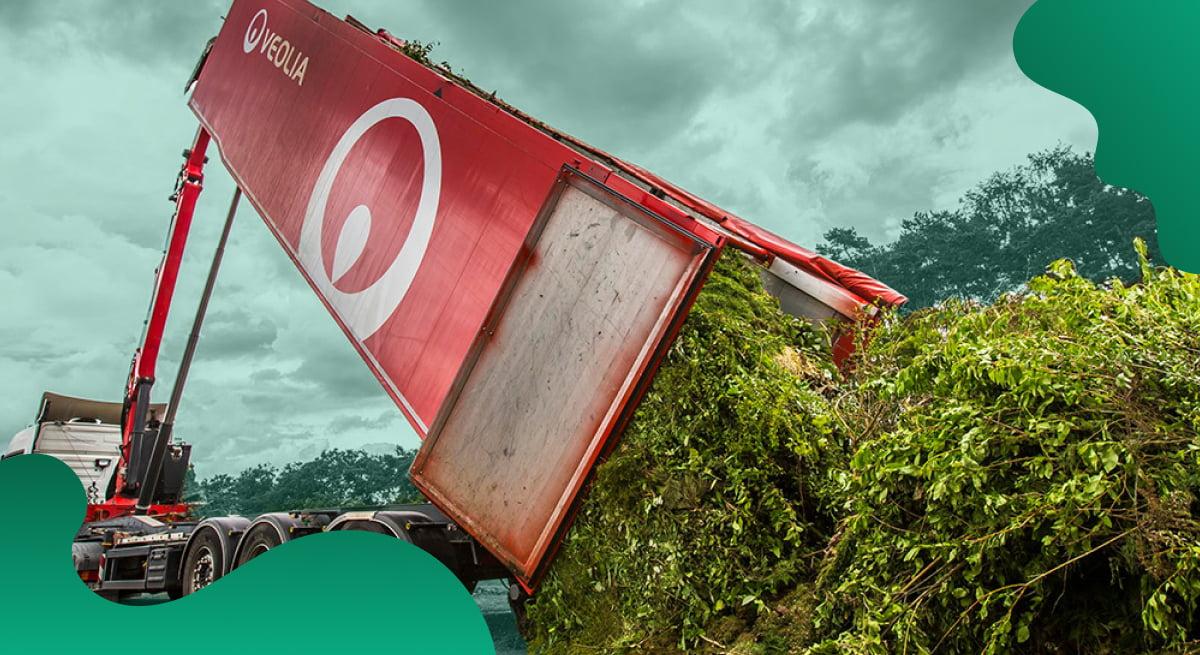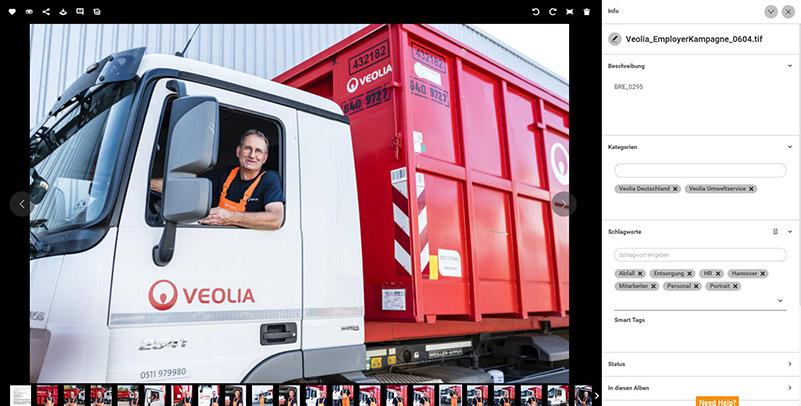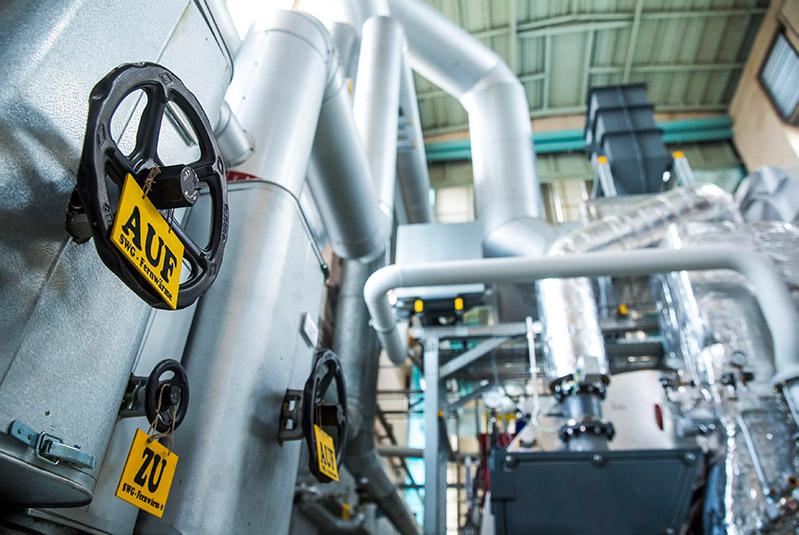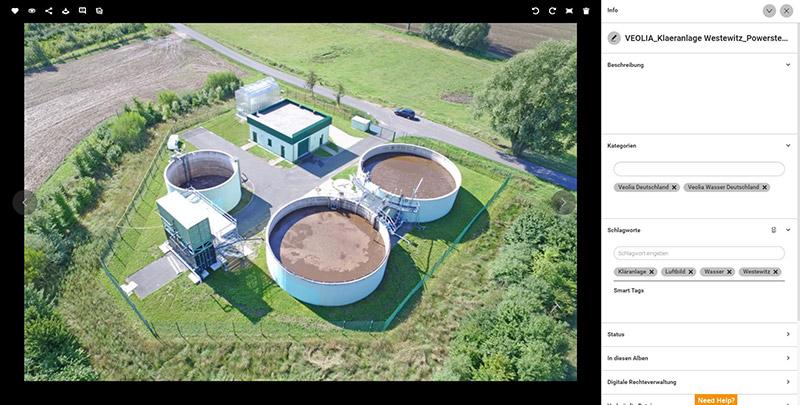Veolia organizes brand assets for international teams with Canto

Lauriane Menuet is a graphic designer at Veolia and primarily supports the communications department in the Berlin office. Her job is to create graphics and other image material which can then be used for flyers, presentations or internal newsletters. As a graphic designer she works with visual assets every day. Accordingly, a well-functioning solution for storing media files, finding them quickly and making them available to colleagues is important for her work.
The challenge
When Lauriane Menuet started working for Veolia in Berlin in January 2018, the company’s media files were organized with a tool that colleagues described as chaotic and not very user-friendly. In fact, there were problems in the production process for graphics because certain files could no longer be assigned – important metadata such as the photographer’s name or the license terms of an illustration simply did not exist.
For Menuet and her colleagues at Veolia, it quickly became clear that a new, more powerful and, above all, more user-friendly solution was needed to organize the media files. As part of the research, Veolia compared different solutions – and eventually chose Canto.
The solution
To harness Canto’s full potential, Lauriane Menuet carried out the migration within a project involving three Veolia employees. First, they selected all relevant media files for further use. Then, they made a critical selection on the basis of this collection: Migration to Canto only made sense when it was clear who needed the content and when.
Based on this selection of media, they developed a metadata structure, which in turn is based on the three areas in which Veolia is active: water, waste disposal and energy. Menuet and her colleagues also considered how the files had previously been organized, what had worked well and what was problematic. The biggest challenge, Menuet describes, was to clarify the image rights that had been lost with the previous tool. In addition to basic copyright information, this includes, for example, which employees are depicted on a photo and whether they have agreed to use the image.
Once this information had been completed and entered, Canto started at Veolia. The media library includes nearly 9,000 media assets, of which 4,000 are available through the internal portal. Seven editors and three administrators take care of the organization of the content.
Results and benefits
With Canto’s internal launch, Veolia has successfully overcome their challenges in media asset management. The various communications departments that operate within their business units can access a central media library to which other relevant teams such as the finance or sustainability departments are connected. More than 90 regular users have now been set up in Canto.
Typical workflows such as creating presentations have become easier and more secure with Canto. Canto allows users to instantly see which images are available to them, and maintenance gives them confidence that the images are approved and relevant. Canto’s content is also used for social media, with intelligent sharing capabilities that make work processes faster and more efficient.
Lauriane Menuet can’t pick just one function of Canto that she loves the most: “There are many features that come into question.” For Veolia, the portals have become an essential prerequisite for day-to-day work. They can also be used to control user access to certain content. “Also the collection links for sharing are an enormous relief,” Menuet reports. “I use them very often to send files to other users who don’t have access to Canto themselves.”
And here’s what our customers said in the interview
No two companies are alike. That’s why we introduce our customers and talk with them about how they use Canto. Veolia assists cities and industrial companies on all five continents in dealing with natural resources. We spoke with Lauriane Menuet about her job as a graphic designer and her work with Canto.
What is your job at Veolia?
I’m a graphic designer at Veolia and mainly support the communications department here at our office in Berlin. My job is to create graphics and other image materials that are then used, e.g. for flyers, presentations or our in-house newsletter. That means that I work a lot with images every day. Accordingly, Canto is a really important tool for my work.
When did you first come into contact with the topic of DAM? And at what point did you decide to implement Canto?
When I started my work for the team in January 2018, there actually was a predecessor tool, however, organizing the stored content was so chaotic and using it so difficult that it had already been decided to replace this tool. Before that, I had never worked with a comparable system for managing media. I actually found this tool to be neither very intuitive nor powerful. It was clear: We need something new! That’s why we decided to check out various other solutions, compare them and then ultimately, we brought in Canto in June 2018.

How did the migration of your new DAM project go with Canto?
In order to migrate our data from the old tool to Canto, we formed a team of three colleagues working from the communications department who were in charge of introducing Canto. That was really a huge, challenging yet also very interesting job! To migrate our content, we first developed a process: In a first step, we initially compiled all our relevant media files and out of these we decided which ones would be needed and by whom.
Based on that, we developed a structure in which we again subdivided media types such as images into the various areas in which Veolia operates: Water, waste disposal and energy. Then, we tried to learn from the mistakes that were made with the old tool so that we didn’t repeat them with Canto.
The biggest challenge was ultimately clarifying information such as image rights. For data protection reasons, before releasing the content, we compiled all the essential information needed to use the image in Canto, e.g. the information about who is depicted on the photo. This data was only partially available or not at all. We also compiled all our considerations and instructions in the form of a manual where we set down and explained rules for use.
So, what does the implementation of your project in Canto look like?
Only administrators and editors work in our main Canto library. That’s where the content is collected and reviewed. As soon as the content is ready for further use, it’s imported into one of our portals. From there, regular users can also access it and then use the media files. This way of organizing things there is very useful for us since we wanted to have more control over who has access to specific content. We can implement all that using the portals.
Which of your departments and colleagues are connected to Canto?
At Veolia, there are various communications departments in charge of the individual business areas, and the teams are all individually connected to Canto. Our colleagues in the finance department or the sustainability department for example also have access. Overall, we have around 90 regular users.

That’s quite a lot. Who is in charge of content and administration for Canto at your company?
We’re a team of seven editors and three administrators who are in charge of organizing Canto. The rules we set at the beginning, based on our prior experience with the old tool and suggestions from our users, are also crucial here.
What types of media files do you manage with Canto?
We centrally manage all types of media files in Canto. Pictures, logos, videos and even manuals are available via Canto. In our main library, we organize nearly 9,000 assets, about 4,000 of which are available via our portal.

So, what does a typical workflow look like there? Where do the files come from?
That varies a lot here. We only purchase images individually. We often hold photo shootings and then import these pictures to Canto. The image material can then be used by all our colleagues via the portals. They’re often used to create presentations. I, of course, also use Canto to research pictures for the print materials that I produce. In addition, the content is also used for social media or outside services. Ultimately, Canto is our central media library.
What is your favorite feature?
There are lots of features that I really like! We probably only use a fraction of Canto’s features. The most important one is probably being able to dynamically manage the copyrights of images with Canto. The portals are also an absolutely essential feature. Because they give us a lot of control over who may view and use which content. This also helps to guide users if they only see what’s relevant for them right from the start. The links for sharing content make life a lot easier! I use them very often to send files to other users who don’t have any access to Canto themselves.

How much time do you spend in Canto per day?
It really varies. Thanks to Canto, searching for images goes a lot faster than before! I don’t waste any time when I look for content. So, on a normal working day, I might spend as much as half an hour using Canto, although I work with images a lot.